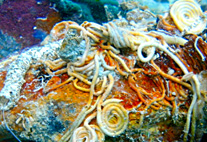Abstract
The Golden Whistler (Aves: Passeriformes: Pachycephalidae) Pachycephala pectoralis sensu lato has long played a key role in the development of the theory of allopatric speciation (Mayr 1932a, b; Mayr 1942; Galbraith 1956). The P. pectoralis species complex formerly comprised 60–70 nominal subspecies and so had a distribution spanning the Indo-Pacific (Boles 2007). More recent taxonomic treatments consider the complex as multiple species-level taxa largely circumscribed by geography (Dickinson and Christidis 2014; Gill and Donsker 2014). In Australia, the endemic species P. pectoralis sensu stricto is sympatric with the closely related Mangrove Golden Whistler P. melanura. However, as the latter’s English name suggests, P. melanura is closely tied to mangroves in Australia, southeast New Guinea, and islets in the Bismarck Archipelago. Diagnostic plumage traits separating the two species are subtle: males of P. melanura have more extensively black tails and a greyer upper surface to the remiges, and females are usually yellower ventrally. All Pachycephala species, especially those in the P. pectoralis-melanura species complex, have recently become the focus of DNA sequence-based studies (Jønsson et al. 2008, 2014; Andersen et al. 2014). Data from most populations have now been analysed phylogenetically to better understand relationships and thus the history of evolution and speciation processes within and between both species. This has also been used in studies of the group’s historical biogeography to provide information as to the age of taxa and their spread across oceanic archipelagos and continents (Jønsson et al. 2014). Here we discuss the taxonomic implications of a result that has emerged consistently and independently in these studies, concerning the systematics of the southern Australian populations in south-eastern and south-western Australia, both of which have been ascribed to P. p. fuliginosa since Galbraith (1956), and we show that the name P. occidentalis Ramsay, 1878 is available for the western population and should be used for it.

